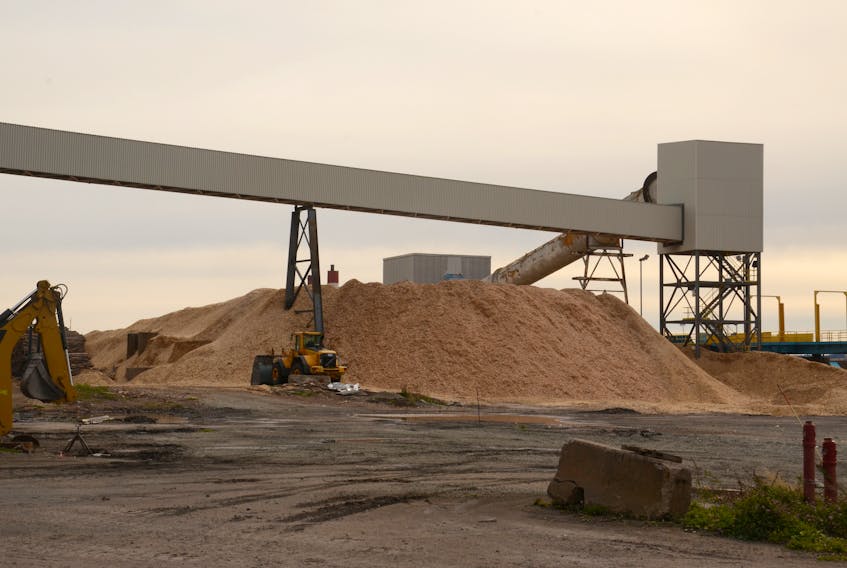In 2010 Brandon Connolly took the advice of his elders.
“I borrowed an old feller’s farm tractor, cut a couple loads of pulp and bought myself a plane ticket to BC with the money,” said Connolly on Friday.
He was 15 years old. Whatever growing up he’d done had mainly been on the safe side of a power saw and he’d never been one for school anyway.
So he left Boylston, Guysborough County and hopped on a plane for British Columbia without anything lined up when he got there.
“I’d worked cutting firewood for Danny George and he drilled it into me – I’d never make it in Nova Scotia because of poor rates, poor wood, poor forest management,” said Connolly. “So I went.”
Now 25, he is the founding owner of Connolly Timber Inc. in Prince George.
He has a new Tiger Cat Processor, a forwarder and a team of employees.
Connolly is looking for two more equipment operators his in box has been flooded since Premier Stephen McNeil’s Dec. 20 Northern Pulp announcement.
“Out here we’re cutting dry, dead red pine and getting $120 a tonne for it while in Nova Scotia you’re only getting $75 a tonne for nice green spruce logs,” said Connolly.
“We get $60 to $80 a tonne for pulpwood. So, our bottom-end product is worth more than your top-end product.”
The price for pulp in Nova Scotia was around $38 a tonne before the Northern Pulp announcement, but right now it is nearly impossible to sell.
To be fair, British Columbia’s forest industry is on hard times as well.
Thousands have been put out of work over the past year by a series of sawmill and pulp and paper mill closures.
Union president for United Steelworkers Local 1-423, Pat McGregor, told Global News in September that a large part of the problem is what the mills are paying for wood.
“Log costs are high,” McGregor was quoted.
“We’re being told 75 per cent of the cost for the employer is getting the wood from the bush into the mill.”
Despite the closures British Columbia still has a much more competitive market because of how many facilities remain open.
“That’s a big part of your problem in Nova Scotia,” said Robert Seymour, a University of Maine professor and a contributor to the Lahey Report into forest management in this province.
While Maine has four pulp and paper mills, Nova Scotia only has two. As of Jan. 31, it will only have one.
Seymour wasn’t suggesting the province’s forests could handle more pulp mills, but pointing to the reality that all our eggs inevitably end up in one basket.
He’s been thinking a lot about our forests and the industry that relies upon them since hearing Northern Pulp would close and he sees no easy answers for the short term.
The $7 million in short-term funding from the transition fund announced by McNeil, he considers a good step to continue investing in the future of the resource. But that money will be spent in a year or two.
One of the recommendations made to the province by industry was that the province’s two biomass boilers – Emera owned Brooklyn Power outside Liverpool and the Point Tupper Generating Station owned by its subsidiary Nova Scotia Power – be legislated as must-run facilities.
That would eat up much of the 700,000 tonnes of wood chips purchased by Northern Pulp from sawmills.
It is a significantly lower-value product that wouldn’t do much to solve the devaluation of stumpage rates to private woodlot owners. It would at least help sawmills by providing some return for the byproduct of lumber production while keeping it from piling up in their yards.
“Ultimately you’re burning green chips that are half water in facilities that are only 30 to 40 per cent efficient in the BTUs that you get out of them, so that’s terrible,” said Seymour.
The province hasn’t thus far shown an interest into designating the facilities as must run, potentially because they are inefficient and would result in electricity price increases for consumers.
A longer term solution to Seymour would be converting public facilities to run on wood pellets or a similar product.
They can be made from hardwood or softwood, are dried and burn at around 80 per cent efficiency.
“They’ve become a very common thing here in the United States – there’s hundreds of them in Vermont alone,” said Seymour.
The province was moving forward on a plan like that before the Northern Pulp situation came to a head.
At a forestry conference in Bible Hill recently, it announced it had a list of hundred buildings that could feasibly be converted and six that it intended to have converted by next winter.
Dalhousie University’s Agricultural Campus in Bible Hill operates a facility that generates electricity off of wood waste.
In October the province issued a Request for Supplier Qualifications for companies able to build, maintain and operate wood furnaces built adjacent to public buildings around the province.
Even a hundred such facilities would not consume as much as Northern Pulp, but it would be a start in what Seymour calls “an environmentally defensible” solution to the need to solve our demand shortcomings.
“Quite literally we’re trying to put everything on the table,” said Jeff Bishop, executive director of Forests Nova Scotia.
“There might be something we’re not thinking of and we’re open to all ideas.”
In this debt driven industry with low margins, there may not be many hands going up to replace forestry contractors that can’t make payments on big machines in the coming months.
Brandon Connolly wouldn't have come back home even for the prices paid before the most recent industry disaster.
“I could never have got to where I am today in Nova Scotia,” said Connolly. “There’d be no future for a young person to be investing in and building their enterprise in Nova Scotia with the rates that are paid there.”
RELATED:
- Premier pledges $7 million to keep silviculture sector alive after Northern Pulp mill closure
- Northern Pulp says it's committed to staying in Nova Scotia
- Northern Pulp to proceed with environmental process
- Forest industry says province had no plan for transition after Northern Pulp decision
- Robin Wilber cut from transition team after saying Northern Pulp considering hot-idle
- Meetings set for forestry workers losing jobs because of Northern Pulp shutdown
- Northern Pulp considering hot-idle option
- Northern Pulp fallout continues
- Determination, defiance in hard-hit Pictou County in the wake of Northern Pulp announcement
- Northern Pulp decision validates rights, First Nations lawyer says









